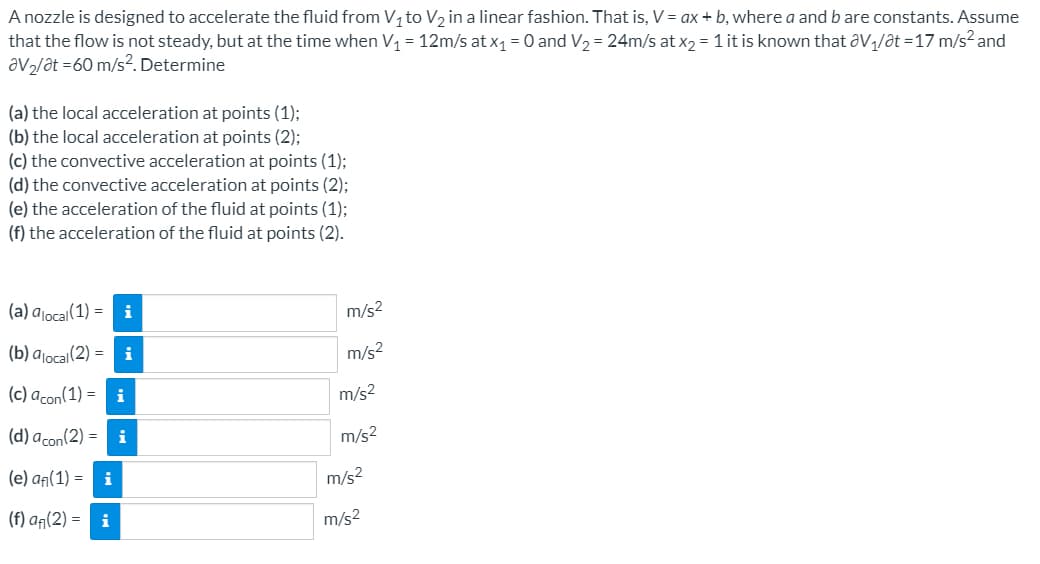A nozzle is designed to accelerate the fluid from V, to V2 in a linear fashion. That is, V = ax + b, where a and b are constants. Assume that the flow is not steady, but at the time when V = 12m/s at x1 = 0 and V2 = 24m/s at x2 = 1 it is known that aV1/at =17 m/s? and aV½/Ət =60 m/s². Determine (a) the local acceleration at points (1); (b) the local acceleration at points (2); (c) the convective acceleration at points (1); (d) the convective acceleration at points (2); (e) the acceleration of the fluid at points (1); (f) the acceleration of the fluid at points (2).
A nozzle is designed to accelerate the fluid from V, to V2 in a linear fashion. That is, V = ax + b, where a and b are constants. Assume that the flow is not steady, but at the time when V = 12m/s at x1 = 0 and V2 = 24m/s at x2 = 1 it is known that aV1/at =17 m/s? and aV½/Ət =60 m/s². Determine (a) the local acceleration at points (1); (b) the local acceleration at points (2); (c) the convective acceleration at points (1); (d) the convective acceleration at points (2); (e) the acceleration of the fluid at points (1); (f) the acceleration of the fluid at points (2).
Chapter2: Loads On Structures
Section: Chapter Questions
Problem 1P
Related questions
Question
Please fast only final answers needed

Transcribed Image Text:A nozzle is designed to accelerate the fluid from V, to V, in a linear fashion. That is, V = ax + b, where a and b are constants. Assume
that the flow is not steady, but at the time when V, = 12m/s at x1 = 0 and V, = 24m/s at x, = 1 it is known that aV,/at =17 m/s? and
av2/Ət =60 m/s². Determine
(a) the local acceleration at points (1);
(b) the local acceleration at points (2);
(c) the convective acceleration at points (1);
(d) the convective acceleration at points (2);
(e) the acceleration of the fluid at points (1);
(f) the acceleration of the fluid at points (2).
(a) ajocal(1) =
m/s2
(b) alocal(2) =
i
m/s2
(c) acon(1) = i
m/s2
(d) acon(2) = i
m/s2
(e) an(1) = i
m/s2
(f) aq(2) = i
m/s2
Expert Solution
This question has been solved!
Explore an expertly crafted, step-by-step solution for a thorough understanding of key concepts.
This is a popular solution!
Trending now
This is a popular solution!
Step by step
Solved in 4 steps with 5 images

Knowledge Booster
Learn more about
Need a deep-dive on the concept behind this application? Look no further. Learn more about this topic, civil-engineering and related others by exploring similar questions and additional content below.Recommended textbooks for you


Structural Analysis (10th Edition)
Civil Engineering
ISBN:
9780134610672
Author:
Russell C. Hibbeler
Publisher:
PEARSON

Principles of Foundation Engineering (MindTap Cou…
Civil Engineering
ISBN:
9781337705028
Author:
Braja M. Das, Nagaratnam Sivakugan
Publisher:
Cengage Learning


Structural Analysis (10th Edition)
Civil Engineering
ISBN:
9780134610672
Author:
Russell C. Hibbeler
Publisher:
PEARSON

Principles of Foundation Engineering (MindTap Cou…
Civil Engineering
ISBN:
9781337705028
Author:
Braja M. Das, Nagaratnam Sivakugan
Publisher:
Cengage Learning

Fundamentals of Structural Analysis
Civil Engineering
ISBN:
9780073398006
Author:
Kenneth M. Leet Emeritus, Chia-Ming Uang, Joel Lanning
Publisher:
McGraw-Hill Education


Traffic and Highway Engineering
Civil Engineering
ISBN:
9781305156241
Author:
Garber, Nicholas J.
Publisher:
Cengage Learning